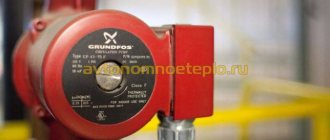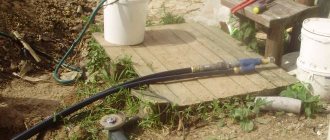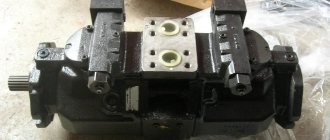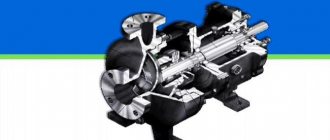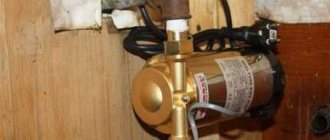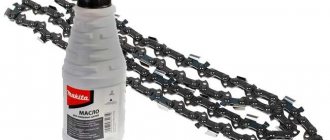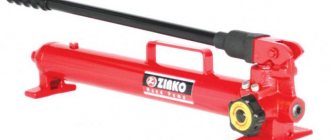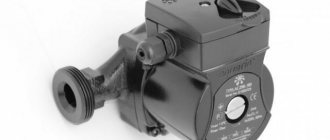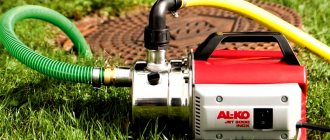Lack of hot water pressure when opening a tap is a fairly common phenomenon found in private and apartment buildings. One of the effective means of solving the problem is a circulation pump for hot water supply.
Installation of pumping equipment for hot water supply, according to existing building codes, is optional for premises with a heated area of up to 500 m²; in practice, installation may be required even if there are 2-3 separate hot water points.
For what purpose and where are recirculation pumps used?
The hot water supply system (DHW) is a closed loop of pipes. The water is heated using a boiler or boiler, or an electric heating element, and then, at the desired temperature, it circulates through the pipeline. To increase its pressure and thus increase the speed of water movement, install a circulation pump for hot water. The purpose of this device is to ensure smooth and fast circulation of water in a closed pipeline system. For this purpose, special elements of the pumping part are used.
The widest area of application of recirculation pumps is heating systems. Since they increase the speed of water movement, the heating itself becomes more economical. Water (or other liquid) acts as a heat carrier. It moves through pipes to all rooms of the house, while giving off heat and providing space heating. Then it returns to the starting point, already cooled, where it heats up again.
If you do not create pressure using a pump, then there will be no forced circulation. The water will move at low speed or stop altogether and not reach the highest points. The result will be uneven heating: some rooms are warm, while in others the pipes and radiators are cold.
DHW recirculation scheme
It is very important to create pressure in the hot water passing system, especially in large houses (over 200 sq.m.), in which water must be supplied at several points (showers, bathrooms), and there is only one heater (boiler or boiler). And it is usually located in the basement of the house or in another room on the ground floor. This results in a large length of pipes, and the water immediately begins to cool before reaching the water intake point, if its pressure is not sufficient. That is, the situation is like this - you opened the tap and are waiting for a long time for hot water to come out. In addition, if several water intake points are open, then the pressure gradually decreases, and at the very end point there may be no pressure at all. The situation is familiar to those who have a large private house, as well as residents of apartment buildings.
A DHW recirculation pump eliminates such discomfort very quickly. It creates pressure and water flows to all faucets, no matter how far they are located from the water heater.
In addition to pressure and uniform distribution, we get another important factor - saving money. After all, hot water, pushed by the pump, moves very quickly and does not have time to cool down much. That is, it is not cold water that returns to the starting point (to the heater), but rather warm water. The thermostat of a boiler or other heater analyzes its temperature and heats it up only a little, using little energy - electricity or gas. That is, the consumption of gas and electricity is reduced, so you save money.
Pump installation location
Thus, heating and hot water supply greatly benefit from installing a circulation pump. This device has also proven itself very well in underfloor heating systems using hot water pipelines. Since pipes under the floor are always thin and have very complex bends, forced circulation is simply necessary for them.
This is interesting: Submersible pumps for a well: which one is better to choose, types and features of well pumps
Why do you need a DHW pump?
The DHW circulation pump is designed to create pressure and constant circulation of water in domestic water supply systems.
After opening the tap, you have to wait a long time for the water to become hot, and the further the water supply point is located from the DHW input, the more time this requires.
The pressure in the system does not always meet even the minimum requirements, preventing you from washing properly. Circulation pumps for domestic hot water are installed for the following purposes:
- Ensure stable pressure in the system - for this, hot water is diverted into a special buffer tank, after which it is supplied under pressure to water supply points.
- Ensure instant supply of hot water - the circulation pump for hot water supply is connected to a closed pipeline. Water is constantly in motion. Thanks to circulation, the cooled liquid mixes with the heated one. As a result, immediately after opening the tap, hot water is supplied to the consumer.
The parameters of the domestic water supply make it necessary to install hot water supply in both private and apartment buildings.
Design
The recirculation pump does not have much power and performance. The device pumps coolant over short distances.
Injecting high pressure from the circulation pump for DHW is not required. The product consists of a housing, an impeller and an electric motor. Under the influence of a magnetic field, when voltage is applied to the motor windings, its armature begins to rotate.
The impeller displaces a mass of water and pumps it into the outlet pipe. Liquid is drawn from the inlet pipe. When selecting a circulation pump, it is necessary to take into account its type and technical characteristics. Regardless of the manufacturer, all recirculation pumps are divided into 2 types - with a wet or dry rotor.
Dry rotor pump
In devices of this type, the water medium is located separately from the parts of the electric motor. The motor is air cooled.
Dry rotor device
A distinctive feature of units with a dry rotor is their high efficiency. Rotating parts of an electric motor require periodic lubrication. This is necessary to reduce the degree of friction between components.
With wet rotor
It’s just that this type of impeller and the armature of the electric motor are completely immersed in a water environment. Units with a wet rotor have a low efficiency.
The advantage of devices of this type is that there is no need to lubricate the rotating parts of the electric motor. Cooling of parts is carried out with water.
Recirculation pumps with a wet rotor are characterized by low noise levels during operation. This allows them to be used in residential areas, both during the day and at night. Often such devices are used in apartments and houses.
Device
The recirculator works on the same principle as the pumps used in heating systems. The main purpose of the installation is to stabilize and increase the pressure of the water supply, which is not enough.
A closed equipment system consists of the following elements:
- storage capacity;
- control and shut-off valves;
- pumping device;
- circuits that connect to water points.
The container is filled with hot water. The temperature range can reach +100 degrees. The pump must create the required pressure, thereby forcing a certain volume of liquid to circulate constantly.
As soon as the consumer opens the tap, he receives hot water, which is supplied under pressure. This allows you to use the bath and shower.
As for the cost, it all depends on the model and manufacturer, prices start from 100–115 euros and above.
Glandless rotor pump
There is a wide selection of models of such equipment on the market. Many devices have an electric motor. All moving elements of the mechanism are completely in the aquatic environment.
This “wet” design has a number of advantages, such as:
- There is virtually no need for maintenance;
- equipment operates without unnecessary noise;
- consumes little electricity.
The water unit consists of a sleeve, a motor stator, a pump housing, which has two mounting holes, bearings and an impeller with blades. The parts are made of stainless steel and therefore do not corrode.
A wet rotor has a number of features, the first of which is low efficiency. It is important to note that the liquid must be clean without additional impurities, so filters will need to be installed.
This device does not tolerate dry running. It must be constantly in an aquatic environment, then the pumping effect is maintained.
Dry rotor device
Such equipment requires the use of conventional oil lubrication to reduce friction in the bearings. The engine chamber is separated from the liquid by a seal on the shaft. As for the case, it is cooled by air.
The features of the unit include its large size and weight. This provides more power, which is why such a device is often used in industrial applications.
The efficiency is high and it makes noise, so the unit is almost never used in individual homes. You can install such a device anywhere, which makes the task easier.
Source: https://stroy-podskazka.ru/vodosnabzhenie/nasosy/cirkulyacionnyj—dlya-gvs/
Operating principle
Circulation pumps are used to constantly move liquid in a hot water system. To connect them, it is necessary to install a storage tank. Liquid is drawn through the inlet pipe of the pump, which creates a vacuum and water from the storage tank enters the circuit.
The pump impeller pumps the liquid, building up pressure in the outlet pipe, while at the same time the cooled water flows back into the container. Thus, with constant operation of the pump, there is a continuous circulation of coolant in the system.
The principle of operation of the pump in the diagram
The hot water supply circuit does not end at the extreme point of water intake, but is connected to a storage tank. Thus, the liquid constantly circulates in the system, regardless of whether the water intake points are open or closed. For ease of use, a shut-off device can be installed on the return flow pipeline. This will shut off the circuit and stop recirculating the hot water supply if necessary.
How does a circulation pump work in a hot water supply system?
The operating principle of the DHW circulation pump is almost identical to that used in heating systems.
The purpose of the installation is to increase and stabilize the missing water supply pressure. Circulation pumps in domestic hot water systems of private residential buildings operate as follows:
- A closed hot water system is installed, consisting of: a storage tank, shut-off and control valves, pumping equipment and a circuit connected to water distribution points.
- Hot water is drawn into the container. The pump creates the necessary pressure, forcing a certain amount of water to constantly circulate in the pipeline circuit.
- When the tap is opened, the consumer immediately receives hot water under pressure, sufficient to take a shower, quickly draw a bath, etc.
Most models of pumping equipment designed for hot water supply have electric motors based on a “wet rotor”. All moving parts are completely immersed in water.
The “wet” design has many advantages: no need for maintenance, quiet operation, low energy costs. Along with this, there is a danger of dry running. The coolant plays the role of a lubricant. Without lubrication, bearings instantly fail.
Circulation pumps used in hot water supply systems of multi-storey residential buildings are often called booster pumps, since their task is mainly to create sufficient pressure in the water supply system.
Source: https://avtonomnoeteplo.ru/armatura/374-kak-podobrat-cirkulyacionnyy-nasos-dlya-kotla.html
How can you control the pump?
Hot water from the taps in the house does not flow constantly, but is consumed according to need. That is, there is no need to constantly turn on the pump. It should turn on when needed and turn off when hot water is not needed. This gentle mode increases the service life of both the recirculation pump and the entire pipe system.
To control the pump on/off, there are two ways:
- Temperature sensors;
- Timer (time programming)
How does a temperature sensor work?
The temperature sensor is located directly in the hot water and monitors its temperature. When the degrees drop to a minimum level, the sensor automatically starts the pump motor. The temperature sensor can be adjusted to any desired temperature value, which makes it possible to save energy. If the water temperature rises to the required level (for example, 50 degrees Celsius), the sensor immediately triggers and turns off the circulation pump.
How does the timer work?
The timer also turns the pump on and off. However, it does not track the water temperature, but is programmed by time intervals. The time depends on the total length of the pipes through which hot water flows, on the performance of the pump, as well as on the quality of the thermal insulation of the premises.
The timer is especially convenient when there is no need for hot water and the residents have left for a while. Then the timer can be set to turn on and off with a period of a week. If you often have similar situations, then it is better to choose a pump with a timer, and your equipment will not run idle.
When installing a circulation pump and connecting it to the heating system or hot water supply pipes, also take into account the connection diagram. It comes in two types:
- Consistent;
- Parallel.
In the first option (series connection), the pump is connected to a closed circuit of pipes in which taps are placed in series. The second option (parallel) is less common. It involves connecting the pump to two or even three circuits using a manifold.
Installation diagrams
There are two ways to connect pumps:
- Consistent in the break of the return line of the contour.
- Parallel with the collector.
The first method is good for systems with a small number of consumption devices and with a short total length of pipeline lines. The pump is connected at the end of the circulation circle, into the return line gap.
The second method is used for a large number of circuits (for example, heated floor loops) . It requires a powerful, productive pump, otherwise you will have to install your own device for each circuit, which increases noise and load on the electrical network.
Adviсe
Before you start looking for pumping equipment, you need to correctly calculate the device parameters. Only after this can you decide on a purchase and invest wisely. Such data includes the workload of the water supply system, as well as sufficient flow strength. An important point is to take into account the number of taps that can be turned on simultaneously. It is necessary to create the same pressure of the circulation pump so that the pressure remains constant everywhere.
If we talk about the average water consumption at one point, it is about one hundred and eighty liters per hour. If a house or apartment has two bathrooms and a kitchen where taps are located, the best choice would be to install a device with a throughput capacity of at least 0.7 cubic meters per hour. We must not forget about the hydraulic resistance of the overall system. Pressure and pressure are affected by the length and height of the pipeline, so these indicators also need to be clarified. A water column of 0.6 meters uses 10 linear meters of contour. The manufacturer always adds technical documentation to each model and type of pumping equipment, so it is worth studying all the indicators and descriptions.
Thanks to such calculations, it is possible to obtain the average heat consumption of hot liquid through a circulation pump, which will help you quickly make a choice and facilitate the purchase. Of course, an industrial-type device is suitable for pumping water at a large enterprise, but slightly different models are suitable for a home.
Today, calculations can be made online thanks to electronic calculators, where the corresponding indicators are entered, which speeds up the solution of the problem. If a pump is selected for an apartment building or a cottage with a large area, such calculations are carried out only by qualified specialists from design and installation organizations, since they are responsible for the performance of the entire system.
To correctly install the pump in a hot water supply system, you must first study the instructions in detail and strictly follow the manufacturer’s recommendations. In addition, building codes are important and must be heeded.
To complete the installation you will need to complete the following steps:
- the installation location of the circulation device is selected. The module must be installed on the return line, which will prevent air from entering, which in turn will lead to a decrease in the functionality of the entire system;
- a check valve must be installed between the pump and the storage tank;
- shut-off valves are installed before and after the station, their number depends on needs;
- A UPS is used for connection. As soon as the power is turned off, it will ensure that the device operates in autonomous mode. The duration of its operation ranges from several hours to a day.
Of course, it is also necessary to choose an uninterruptible power supply according to certain parameters, taking into account the rules. Uniform distribution of pressure is an important task. For this purpose, special manifolds and pressure-reducing valves are used. You cannot run the electric motor idle, which will negatively affect its performance and the device will quickly fail. After installing the pump in the DHW system, it is necessary to fill the water circuit and do a test run to check the functionality of the mechanism.
The device with a wet rotor is a simple design that does not require regular inspection or even repair, which is one of the main advantages of this equipment. The only thing you need to do is clean and replace the filter if necessary. Glanded rotor pumps require maintenance once every two years. It is necessary to replace the lubricant and clean the housing for the device to operate smoothly. If desired, you can consult with qualified specialists to make the right choice.
In the next video you will find a review of the surface circulation pump GRUNDFOS UP 15-14 B.
This is interesting: Circulation pumps for heating: varieties, selection rules, installation
Calculations before purchasing
When choosing a pump, you must first take into account its purpose and operating conditions. A simple calculation will help you determine the basic parameters, which is recommended to be performed before selecting a particular model. This will ensure normal operation of the system and increase the service life of the device.
The circulation pump for the heating circuit is calculated using the formula:
Q=0.86R/TF-TR, where:
- Q—pump capacity (calculated);
- R is the thermal power required to heat a given room (at the rate of 1 kW per 10 m2);
- TF - coolant temperature at the inlet to the radiator system;
- TR is the temperature of the coolant at the outlet of the radiator system.
For example, to heat a house with an area of 100 m2, a thermal power of 10 kW will be required. If the temperature difference is 20° (at the starting point 75° and at the final point 55°), then we get the following result: 0.43 m3/hour.
The example given is slightly simplified for clarity . As a rule, knowing the performance of the pump, it is quite possible to choose a specific model without wasting time on calculating other parameters.
The calculation of the DHW pump can be omitted, guided by simple considerations. In a hot water supply system, the water is already under a certain pressure, otherwise it will not flow out of the tap.
If its circulation is organized, it is enough to slightly increase the pressure to force the flow to move. Any low-power pump designed to work with water at temperatures up to 65° is suitable for this.
What indicators need to be taken into account when choosing
We begin the selection of a circulation pump for hot water supply with indicators of its performance and pressure.
- Productivity is the volume of water (or other liquid) that the pump pumps in a certain unit of time (cubic meters per hour or liters per minute);
- Pressure is the pressure created by the pump (measured in Bars, Pascals or lift height in meters).
In addition, we also take into account the technical characteristics:
- Power of the installed electric motor in W;
- Type of control (temperature sensor or timer).
Capacity depends on the length of the pipe system. If the total length of the pipeline is 40-50 meters (an average house), then a pump with a capacity of 0.2 to 0.6 cubic meters per hour will be sufficient.
The motor power should also be low so as not to waste electricity. On average, the figure for a small private house, cottage, cottage is from 5 to 10 W. For large houses with several floors, 20 W of power is sufficient.
The choice of a circulation pump for hot water supply according to the characteristics of its pressure (lift height) will be correct if one is guided by the following rules:
- For a one-story house, where the pipeline is single-level, we take a pressure with a height of water rising from half a meter to 0.8 meters;
- For a building with several floors, add the height of the water supply pipes;
- Plus - we create a certain pressure reserve, 10-20 percent.
Main characteristics
When choosing a circulation pump for domestic hot water or heating, you should pay attention to the following characteristics:
- productivity – the amount of liquid that a recirculation electric pump is capable of pumping per unit of time (m3/hour or liter/min);
- pressure or pressure of the liquid medium created by the pump (meters of water column or Pa);
- power consumed by the recirculation pump (W);
- method of controlling the device (using a timer or temperature sensor).
Since recirculation pumps pump small volumes of liquid, which moves in heating pipes or water pipes at low speed, such devices do not require high power and performance. Thus, to maintain the water temperature in domestic heating and water consumption systems, the length of which does not exceed 40–50 meters, a recirculation pump with a capacity of 0.2–0.6 m3/hour will be quite sufficient.
Grundfos pump with a capacity of 3.3 cubic meters. m/hour
In terms of electricity consumption, boiler and hot water pumps are also economical, since their power, depending on the model, ranges from 5 to 20 W. This is quite enough for the electric water pump to be able to ensure efficient circulation through the hot water pipes in a private house.
It is very important to choose the right circulation pump according to such a parameter as the pressure of the liquid flow that it is capable of creating.
To choose the right pump according to this characteristic, you can follow the following recommendations when selecting recirculation equipment for heating and hot water systems of both a small residential building and a large cottage with several floors.
- If the pipes through which the pump must circulate the liquid medium are located at the same level, then we select equipment with a pressure value of 0.5–0.8 meters of water column.
- If the house has several floors, DHW recirculation must be ensured at several levels of the pipeline, which means that the height to which the liquid must be raised must be taken into account.
In order to make recirculation of the liquid medium more efficient in heating and hot water systems, pumps should be selected with a certain reserve in the pressure generated.
Recommendations for proper pump installation
To ensure convenient access for servicing the pump, the unit must be connected correctly. In practice, when installing a pump, the following basic installation rules should be taken into account:
After installing the circulation pump, it should always be accessible so that in the event of a breakdown, it can be easily repaired or replaced.
- Both sides of the pumping unit must be equipped with special ball valves, which are necessary when carrying out maintenance of the entire heating system or during the dismantling of the unit.
- It is necessary to equip the entire system with a filter in order to protect the device from exposure to small particles that lead to damage to the installation and its components.
- Since the water passing through the heating system is far from ideal, additional protection will be required for the pumps to function properly. Therefore, the heating bypass on top must be equipped with a valve, which must be installed. You can choose any valve: automatic or manual. Its purpose is to release air pockets formed in the pipes; its terminals should be directed clearly upward.
- Belonging to the type of wet models, the pump must be installed in a horizontal position so that it is completely immersed in water, and not just a separate part. Incorrect installation can cause damage to the working surface of the unit, and the installation will be pointless.
- To increase the operating potential of the structure, it is necessary to specially treat all fasteners and connections in the system with a sealing agent.
- It is necessary to ensure that the sequence is observed when connecting the pump and fasteners.
Criterias of choice
The choice of one model or another is determined by several criteria:
- Purpose of the device, type of system where it will work.
- Specifications.
- Construction type.
- Manufacturer.
- Price.
The last two points are no less important, since they determine the quality, durability of the pump, and the cost of its purchase.
When choosing a device, you should not hesitate to consult with the seller. If you decide to buy an expensive pump from a well-known company, you need to ask the seller to show the certificate of conformity for the device.
If it's not a fake, there won't be any problems. Otherwise, you should refuse the purchase and look in another store.
Varieties
There are two types of recirculation pumps for domestic hot water:
Place of the pump in the DHW system
- reverse (installed on the pipeline for return water supply);
- supply (mounted on pipes for supplying hot water from the heater).
Both of these types are used in closed loop systems.
Based on their design features, units providing hot water supply are divided into two types:
- Units with wet rotor. In this type of recirculation pump, the pressure part is located inside the pumped liquid. Water performs the function of lubrication and cooling. Such devices have a long service life and low noise operation. They do not require maintenance and are affordable. The disadvantages of this equipment include low efficiency (40-45%), as well as the method of installation only in a horizontal position. Used in small houses for heating and water supply systems. Capable of creating pressure up to 1.5-3 atm.
- Devices with dry rotor. In such pumps, the power unit and the pumped liquid are separated from each other. Circulation pumps with a dry rotor require periodic inspection, during which lubrication is carried out. There is a built-in fan to cool the engine. The cost of maintenance and the device itself is higher than a unit with a wet rotor. But productivity is also higher, it is about 70%. The pressure is increased to 5-10 atm. Disadvantages include increased noise levels during operation and high cost. Used in industry and for centralized heating and water supply systems.
Depending on the switching speeds, there are the following models:
- multi-speed - switches the operating algorithm. Used in houses with a large area, more expensive;
- single-speed - have reduced performance, suitable for domestic use. Easy to install and work independently.
Model selection
The main task of the recirculation pump is to maintain the optimal speed of hot water through the pipeline, at which the temperature of the water in the return pipe will be within the required limits. The choice of unit is made taking into account the following parameters:
Calculation of parameters for choosing a DHW pump
- the maximum pressure of a liquid, which is measured by the height of the water column. Pressure affects the pressure and temperature of water circulating through the pipeline;
- fluid consumption. The formula calculates the difference in water temperature between the supply and return pipes. The power of the heating equipment is divided by the resulting number;
- heat transfer of the heating system. It is calculated depending on the area of the room that is heated and the expected heat loss.
The recirculation electric pump must be selected taking into account these parameters. This is the work of an experienced designer.
Kinds
There are many types of pumps. They differ from each other in their technical characteristics and purpose. There are pumps:
Drainage. Used to pump excess ground (soil) water.- Submersible. This pump must be submerged in water to operate properly.
- Self-priming (or surface) . The suction pipe is lowered into the water, and the pump itself is on the surface.
- Increasing pressure (or increasing) . Used to increase pressure in the system, ensures normal operation of plumbing fixtures, washing machines and dishwashers.
- Industrial. Unlike the household model, the industrial model has increased power, durability, and is able to work in difficult conditions. The cost of industrial models is significantly higher than that of household ones.
It must be taken into account that circulation pumps are allocated to a separate group.
They are also divided into two categories:
- for DHW;
- for heating.
The first category is designed for a maximum water temperature of up to 65°, the second is capable of working with water heated to 90°.
Pressure and capacity also differ (heating pumps usually show higher values).
Purpose and scope
Hot water recirculation pumps have a very important function. With the help of such devices, closed pipelines through which hot water is transported operate in the required mode. By pumping liquid into the pipeline due to the rotation of special elements, recirculation electric pumps increase the pressure of the liquid medium they pump and, accordingly, the speed of its movement.
Most often, heating systems are equipped with recirculation pumps, which increases not only the efficiency, but also the cost-effectiveness of the latter. Most of these systems, as is known, operate using a coolant, which, moving through a pipeline, releases heat into the room. Heating of the coolant (in this case, before it is supplied to the pipeline) is provided by a boiler, boiler or water heater. After passing through the entire heating circuit, the water must return to the heating equipment, where it is again given the required temperature.
DHW recirculation scheme
Without the use of special pumping equipment, water circulation in the heating system will flow slowly, and in some cases may not flow at all, since the pressure of the coolant flow, which is not further increased in any way, will be dampened by the pipeline elements. The result of this is unevenly heated heating pipes and, accordingly, an uncomfortable temperature in the premises of the house.
A circulation pump for hot water supply increases the pressure and pressure of hot liquid moving through a closed pipeline circuit. The use of circulation pumps for hot water is especially important in the pipeline systems of houses with an area of more than 200 m2, in which there are several water intake points, and the boiler is installed in a separate room or in the basement. Water in such pipelines (as a rule, quite long), if they do not have a recirculation system using a special pump, cools down quite quickly. This leads to the fact that when you open the tap you have to wait a long time until liquid heated to the required temperature flows out of it.
In addition, when some taps at water intake points are opened immediately, the water pressure in them drops, because the pressure of the liquid moving through the pipeline by gravity is not additionally supported by anything. To solve precisely these problems faced by owners of private and apartment buildings, a hot water pump is designed to provide forced movement, as well as the creation of stable water pressure and pressure in the hot water supply system.
The recirculation pump should not be installed near tanks or water heaters, the heat from which could affect the thermostat.
Using a circulation pump for heating and hot water supply to a private home, in addition to the above advantages, allows you to save on energy costs. Since in systems with recirculation, water from the boiler is transported through pipes forcibly and reaches all water intake points and heating radiators much faster, its temperature during such transportation decreases slightly. A boiler, if forced water recirculation is provided in the pipeline it serves, requires less time to heat it, and accordingly, the consumption of energy carriers used to operate the heating equipment is reduced.
Pumps for circulating hot water are actively used to equip “warm floor” systems, the design of which assumes the presence of an extended pipeline circuit of a complex configuration, consisting of small-diameter pipes. In such cases, the circulation pump ensures constant movement of the coolant through the pipes.
The circulation pump is a mandatory element of the underfloor heating system
Where to put
It is recommended to install a circulation pump after the boiler, before the first branch, but on the supply or return pipeline it doesn’t matter. Modern units are made from materials that can withstand temperatures up to 100-115°C. There are few heating systems that work with a hotter coolant, so considerations of a more “comfortable” temperature are untenable, but if you feel safer, put it in the return line.
Can be installed in the return or direct pipeline after/before the boiler up to the first branch
There is no difference in hydraulics - the boiler, and the rest of the system; it makes absolutely no difference whether there is a pump in the supply or return branch. What matters is the correct installation, in terms of strapping, and the correct orientation of the rotor in space
Nothing else matters
There is one important point regarding the installation location. If the heating system has two separate branches - on the right and left wings of the house or on the first and second floor - it makes sense to install a separate unit on each, and not one common one - directly after the boiler. Moreover, the same rule remains on these branches: immediately after the boiler, before the first branch in this heating circuit. This will make it possible to set the required thermal conditions in each part of the house independently of the other, and also in two-story houses to save on heating. How? Due to the fact that the second floor is usually much warmer than the first floor and much less heat is required there. If there are two pumps in the branch that goes up, the speed of movement of the coolant is set much lower, and this allows you to burn less fuel, without compromising the comfort of living.
There are two types of heating systems - forced and natural circulation. Systems with forced circulation cannot work without a pump; systems with natural circulation work, but in this mode they have lower heat transfer. However, less heat is still much better than no heat at all, so in areas where electricity is often cut off, the system is designed as hydraulic (with natural circulation), and then a pump is installed into it. This gives high heating efficiency and reliability. It is clear that the installation of a circulation pump in these systems is different.
All heating systems with heated floors are forced - without a pump, the coolant will not pass through such large circuits
Forced circulation
Since a forced circulation heating system without a pump is inoperative, it is installed directly into the gap in the supply or return pipe (of your choice).
Most problems with the circulation pump arise due to the presence of mechanical impurities (sand, other abrasive particles) in the coolant. They can jam the impeller and stop the motor. Therefore, a mesh dirt filter must be placed in front of the unit.
Installing a circulation pump in a forced circulation system
It is also advisable to install ball valves on both sides. They will make it possible to replace or repair the device without draining the coolant from the system. Turn off the taps and remove the unit. Only that part of the water that was directly in this piece of the system is drained.
Natural circulation
The piping of the circulation pump in gravity systems has one significant difference - a bypass is required. This is a jumper that makes the system operational when the pump is not working. One ball shut-off valve is installed on the bypass, which is closed the entire time the pumping is running. In this mode, the system operates as forced.
Installation diagram of a circulation pump in a system with natural circulation
When the electricity goes out or the unit fails, the valve on the jumper is opened, the valve leading to the pump is closed, and the system operates as a gravity system.
Installation features
There is one important point, without which the installation of the circulation pump will require rework: it is necessary to rotate the rotor so that it is directed horizontally. The second point is the direction of flow. There is an arrow on the body indicating which direction the coolant should flow. This is how you turn the unit so that the direction of movement of the coolant is “in the direction of the arrow”.
The pump itself can be installed both horizontally and vertically, just when selecting a model, make sure that it can work in both positions. And one more thing: with a vertical arrangement, the power (pressure created) drops by about 30%. This must be taken into account when choosing a model.
Unit features
The principle of operation of circulation pumping equipment is based on creating continuous circulation of liquid in the system without changing the pressure indicator
A circulation pump is a device that operates in a closed heating system and moves water in a pipeline. The unit maintains a certain temperature of the coolant in the system. The device does not replenish coolant losses and does not refill the system. The system is filled using a special pump or a certain pressure in the pipes.
The principle of operation of circulation pumping equipment is based on creating continuous circulation of liquid in the system without changing the pressure indicator. Since after installation the device operates constantly, the main requirements for such pumps are low noise level during operation, economical energy consumption, reliability, durability and ease of use.
Important: circulation pumps are compact devices that do not take up much space and do not create noise during operation. The scope of use of circulation units for heating systems is quite extensive.
They are installed:
The scope of use of circulation units for heating systems is quite extensive. They are installed:
- in traditional radiator systems;
- when installing a water heated floor;
- in geothermal systems;
- when organizing hot water supply for cottages and dachas.
Unlike forced circulation systems, this pumping equipment does not require pipes with an increased diameter. In addition, the device has the following advantages:
- speed of heating the room;
- the boiler can be installed in any suitable place;
- coolant losses and air pockets are minimized;
- The thermal relay ensures automatic control of temperature conditions;
- Electricity costs are reduced due to the use of automatic rotor speed control;
- Since liquid is constantly supplied to heating devices, their service life is extended.
How to make the first launch?
The first start-up, as a rule, is made after the device is fully connected, the entire line is assembled and filled with water.
It is prohibited by the instructions to turn on the pump dry. This is fraught with breakdown and failure, as well as refusal of the warranty workshop to carry out repairs.
Before starting, you need to make sure that the system is completely ready for operation . Most designs automatically remove air when a special screw is turned.
You need to unscrew it half a turn (or more) and wait a few seconds until the air comes out and water flows out. For other pumps it is necessary to install a special air venting element (Maevsky valve).
Control method
Maintaining the circulation of hot liquid at all times is acceptable, although this is not always economically justified. Many will agree that there is not always a need for such water, so there is no need for the pump to work non-stop. If the pipes are routed correctly and thermal insulation is installed, the liquid will not immediately cool down. As far as monetary costs are concerned, this will not affect them since recirculation pumps are inexpensive to maintain.
The control method can be by timer, that is, schedule, and by temperature sensors.
The most common types of breakdowns and how to fix them
The most common type of breakdown is the impeller stopping. The device hums but does not work properly. To solve the problem, you need to turn off the circulation, drain the water, disassemble the device and move the impeller. Typically, the cause is the adhesion of small particles or the entry of foreign objects into the flow.
The second most common type of malfunction is overheating . It occurs due to lack of lubrication on the bearings or due to the regular entry of air into the system. The problem can be solved if the rotating parts are well lubricated and all connections are reliably sealed.
Everything you need to know about hot water is presented in this section of the site.
Connecting equipment
This equipment is installed on direct or return pipes. For heated floors, it is better to connect a pump to the return pipe to stimulate water movement.
For long-distance hot water pipelines, it is recommended to install them on a direct supply pipe. Then all residents of the house will receive hot water in the required quantity.
Circulation pump installation steps:
- assembly of the mechanism using the included instructions;
- choosing a location for installation;
- water supply shutdown;
- cutting and removing part of the pipe;
- connecting the pump using flanged or threaded connections;
- sealing joints;
- connection to the electrical network;
- setting up operation and testing the mechanism.
Recirculation pump (DHW) WILO STAR-Z NOVA A
To achieve maximum functionality of the system, it is recommended to install the pump in a pocket. This is a pipe branch cut off by shut-off valves. In this case, the system can be easily switched off and dismantled if necessary, and the coolant is reoriented to the central branch.
Installation Tips
When installing the pump, keep the following points in mind:
- The device is installed only after complete removal of air from the system and filling it with water. Dry running will damage the device;
- when installing devices with a wet rotor, the shaft must be in a horizontal position;
- You cannot install a pump with a higher capacity than necessary. Otherwise, noise will appear in the pipes;
- before starting, the system is thoroughly flushed;
- you need to make sure that air can be removed from the pipes and pump;
- equipment with a thermostat cannot be mounted near heating tanks, they will overheat the device;
- with a closed system, the unit is installed on the return line, where the water temperature is lowest.
Model for DHW WILO STAR-Z NOVA (VIDEO)
Launch rules
After installation of the unit, startup is carried out. To do this, perform the following steps:
- water pipes are filled with water and static pressure is created in the system;
- an automatic air vent or tap removes air from the mechanism;
- the heater turns on;
- the pump is turned on and the water circulation through the pipes is checked;
- After a few minutes of operation, the pump turns off and the remaining air is removed from the system.
The most common types of breakdowns
Failure can occur for several reasons:
- dry running - pump operation without coolant is prohibited;
- water hammer - to avoid it, the pump is manually filled with liquid before starting;
- water freezing - when the device is not in use, the liquid is drained.
With proper installation and operation of the pump, it will work properly for a long time.
Video description
Video review of what a DHW recirculation system is and the rules for choosing a pump for it:
In this case, the standard installation procedure in the DHW circuit of a private house is carried out according to the following algorithm:
- Assembling the device in accordance with the technical documentation.
- Determining the installation location in the circuit.
- Shutting off the feed.
- Cutting out part of the pipeline at the installation site.
- Connecting the device.
- Sealing and checking joints for leaks.
- Turning on the water supply, connecting equipment.
- Configuration and performance testing.
Advice! To facilitate equipment maintenance and maintain maximum system functionality, it is best to install the device in a so-called pocket. This is a special outlet separated from the pipeline by shut-off valves. If necessary, the pump can be quickly turned off and dismantled, replaced with a new one or repaired - without stopping the coolant.
Conclusions and useful video on the topic
The operation of a booster pump in an apartment in a multi-storey building is clearly shown in the following video:
Educational video on installing a booster pump:
Many models of booster pumps can be easily installed independently. Even a novice plumber can cope with this task without any problems. But the level of comfort with normal water pressure in the system will increase very noticeably.
Interested in information or have questions? Please leave comments on the article and post thematic photos. Perhaps you have useful information in your arsenal that you are ready to share with site visitors.
Installation of pumping equipment for hot water supply, according to existing building codes, is optional for premises with a heated area of up to 500 m²; in practice, installation may be required even if there are 2-3 separate hot water points.
Installation principles for self-priming models
Installing a pump of this type is not particularly difficult. To do this, you will need approximately the same skills and tools that are needed to install other types of pumping equipment.
Schematically, the installation of a booster pump can be represented in the following steps:
- Choosing a location for the accumulator and pump.
- Installation of a hydraulic accumulator.
- Installation of pipes for connecting equipment to the water supply.
- Hanging the pump from the wall.
- Pump and accumulator piping.
- Checking the operation of equipment in automatic mode.
In fact, a pump and accumulator with a pressure switch is a variation of a pumping station. To implement the installation of such a system of devices, you first need to find a place to place the tank.
Some craftsmen replace the hydraulic accumulator with a membrane with an ordinary large capacity, for example, a 200-liter plastic tank.
Instead of a pressure switch, the tank is equipped with a float switch to ensure that it automatically fills as needed. Such a tank is installed as high as possible: in the attic or on the top floor. You should immediately think not only about the size, but also about the configuration of the container.
The flat and narrow tank will take up less space than a traditional cylindrical model. Although there are no special requirements for the configuration of the container. When choosing a location for a container, you should provide access to the tank/hydraulic accumulator or the ability to easily dismantle this element. This is necessary to perform maintenance, repair or replacement of the device.
Hydraulic accumulators are supplied ready for installation, but the tank should be prepared. There are holes in it for water inflow and intake. You can also make a separate shut-off valve to drain the water in an emergency. The pipes for supplying water to the tank and taking it into the water supply system are mounted to one water pipe.
In modern conditions, it is more logical to use easy-to-install and reliable plastic pipes for installing water supply systems.
To prevent air from being sucked into the tank from the pump, and also to prevent water from entering there when the equipment is turned off, check valves should be installed on both pipes. After this, pipes are installed to connect the tank to the water supply system.
Once the tank or accumulator has been installed and the necessary water pipes have been laid, you can begin installing the suction pump. Typically, such a device is supplied disassembled. It is first assembled and then installation begins.
If you decide to mount the pump on the wall, you should first make markings for the fasteners. The pump is then suspended and connected to the water supply pipes. Overall, this is not a very complicated operation. An important point is the direction of the fluid in the pump. It is indicated on the body with special marks.
The pump should be installed in such a way that the water flows from the tank to the water collection points. Thus, the installation and connection diagram for the pressure booster pump is as follows: hydraulic accumulator-pump-consumer. Then the pump is connected.
All connections must be carefully sealed. If threaded connections are used to connect the booster pump, a suitable sealant should be used: FUM tape, flax thread, etc.
The amount of sealant should be sufficient, but not excessive. The device is connected to plastic pipes using special fittings.
After this, you should check the operation of the entire system. If a tank with a float sensor was used, fill it with water. They check not only the operation of the sensor. The container that serves as a storage tank should be checked for leaks. If everything is in order, you can proceed to testing the operation of the pump itself.
The pump must be connected to the electrical network. It is recommended to move the pump switch lever to the position corresponding to automatic mode. All that remains is to open the nearest water tap and observe the operation of the device. If the installation is done correctly, the pump should automatically turn on and the water pressure will increase noticeably.
Pressure boosting circulation pumps are installed in a similar manner. A suitable place in the water supply is chosen for them, and they are inserted there. In this case, it is also extremely important to connect the pump correctly, taking into account the direction of fluid flow. If the position of the device is incorrect, the pump will still allow a flow of water.
But its work will be extremely ineffective, since the device simply will not function. The instructions and the housing indicate in detail the correct position of the pump.
After installation, the pump is connected to the electrical network and its operation is checked. If the water pressure at the nearest water intake point has increased, it means that the installation was completed correctly.
Installing a system with a hydraulic accumulator looks a little more complicated. First you need to understand the structure of the entire structure.
The pump is connected to the hydraulic accumulator using special hoses. Then a pressure switch is connected, with which the equipment will be turned on and off.
The relay setting deserves special attention. Before starting work, it is recommended to carefully study the instructions and recommendations of the manufacturer.
If the knowledge and skills for high-quality installation and configuration of equipment are not enough, it is better to contact a specialist for advice or completely entrust him with all the work.
